by Jenny Savely | May 20, 2016

Danielle with her state officer team and Adam Putnam, Florida Commissioner of Agriculture and 4-H Alum.
How do you 4-H? Through 4-H, youth can participate in clubs, mentorship, project mastery, competitions, local, state, and international trips, and service opportunities unlike any other youth development program in the country. Along with specific skills, 4-H also works to impart life skills, or workforce readiness skills, to its youth. One of the best ways 4-H teaches leadership and responsibility to youth is by giving youth the power to choose how involved they will be and take ownership over what their experience will look like. When youth choose in fully to 4-H, the results are remarkable and inspiring. When our Senior 4-H’ers (14-18 year olds) take advantage of all that is available to them, the impact is a rewarding one. One can observe Senior aged 4-H’ers youth who are both driven to challenge themselves and who take ownership of their own success in 4-H and of their county and state program at large. One such extraordinary example is State 4-H Council Treasurer, Danielle Tinker of Escambia County, FL.
Danielle affectionately says she had to “beg” her mother to get her involved in 4-H. That kind of drive is indicative of the approach Danielle has taken in her 4-H experience overall. “One of the greatest things about 4-H is that it has given me opportunities to try so many new and different things. Some of them… I am glad to have been exposed to them and had opportunity to learn about those things…Then there are areas and events that have changed who I am and where I will end up in life.” Because Senior 4-H youth are able to define their experience, they can explore the depth of their interest area. Sometimes only by trying on various projects do youth find the field that drives them most of all. After pursuing projects like hiking, camping, drama, participating in the fair exhibits, and consumer judging competitions, Danielle got involved in leadership and livestock raising. Here Danielle found her niche. She has passionately pursued many leadership roles at the club, county, and state level and succeeded in her goal to be part of the process of improving the program and spurring others to be involved. Her love of leadership and livestock together have helped Danielle to define her goals in a way that captures both areas, saying that “Through 4-H I have discovered that I love raising livestock and I hope someday to have my own farm where I can raise and care for livestock.”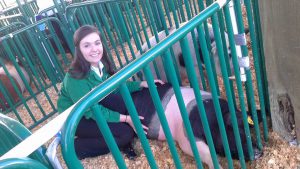 Her entrepreneurial spirit, developing mastery in hog raising, and the leadership skills she has learned will translate into the lifelong values and behavioral change we see in many of our 4-H’ers that have let their experiences direct how they think of others, themselves, and their place in the world.
Her entrepreneurial spirit, developing mastery in hog raising, and the leadership skills she has learned will translate into the lifelong values and behavioral change we see in many of our 4-H’ers that have let their experiences direct how they think of others, themselves, and their place in the world.
Being able to translate skills like leadership, responsibility, communication, resourcefulness, and being goal oriented from a specific task or project to all aspects of life is the type of behavior change positive youth development strives for. When asked about the benefits of 4-H, Danielle said,
“4-H has helped me develop skills that I can use in my future such as self confidence, public speaking and time management…Maybe most importantly through the leadership opportunities, events, and trainings that I have had in 4-H, I will never be the same. I have gained confidence, skills, and abilities that I can carry with me into whatever my future holds.”
Though all 4-H youth develop these skills, as youth age into being a Senior 4-H’er, many new opportunities become available that put them at the center of their county and state programming. Projects, leadership opportunities, and travel for this group is much more challenging and autonomous than the mentor heavy experience of younger 4-H’ers. Youth are able to meet with their peers throughout the state and nation who are delving into making what they experience in 4-H part of their lifelong vision and goals for themselves.
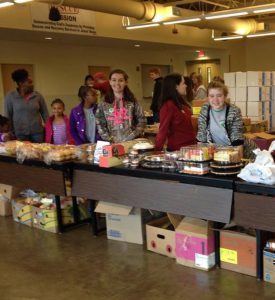 One of the most important skills 4-H teaches is to use your head, heart, hands, and health not only for oneself but for club, community, country, and world. Years of community service through 4-H have helped to mold Danielle into an empathetic and thoughtful young woman.
One of the most important skills 4-H teaches is to use your head, heart, hands, and health not only for oneself but for club, community, country, and world. Years of community service through 4-H have helped to mold Danielle into an empathetic and thoughtful young woman.
“I have learned about compassion for others through community service, and gained a passion for teaching and helping others get the most out of the opportunities afforded them through 4-H and that understanding will go with me in whatever I am passionate about as an adult.” While Danielle has pursued 4-H to the hilt, there is something to be gained through every experience.
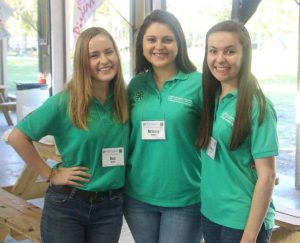
Senior 4-H’ers can choose to be part of many incredible experiences that are exciting, rewarding, and continually challenge them in the moment as well as throughout their lives. 4-H is a program for all ages. Get on board. Contact your local county agent or look into all the incredible opportunities at the Florida 4-H website.
by Melanie Taylor | Mar 24, 2016

Use St. Patrick’s Day to learn about Irish culture in your 4-H club
I just discovered a few years ago that my great-grandmother, whom I never met, was an Irish redhead. I found this very exciting. It made me much more interested in learning about the history of St. Patrick’s Day, beyond wearing green. We live in a culture where we look for the next person or event to celebrate. For those who are Irish, St. Patrick’s Day is a time to reflect and celebrate their culture and traditions. So, although you may not be Irish, why not learn more about the Irish culture and why they are proud of their heritage? At your March 4-H club meetings, it would be fun to celebrate St. Patrick’s Day and incorporate the four-leaf clover and relate it back to the 4-H clover and what they both represent. Whether you are a 4-H leader or a teacher or parent looking for creative ideas, I hope you enjoy this brief history lesson and a few suggestions.
Let’s start from the beginning…
Who was St. Patrick? St. Patrick is the beloved patron saint of Ireland. The Irish are famous for spinning exaggerated tales. Despite the infamous stories traditionally attributed to St Patrick, this is what we actually known about his life. We do know that St. Patrick was born in Britain and that at the age of 16 was captured by Irish raiders who attacked his family’s estate. He was then transported to Ireland where he was held captive for six years, living a solitary, lonely life as a shepherd. It was then that he became a devout Christian, embracing his religion for solace. From his writing, we know that a voice, which he believed to be that of God, spoke to him in a dream, urging him to leave Ireland. He did. Walking nearly 200 miles, St. Patrick escaped to Britain and undertook serious religious training.
After 15 years of study, Patrick was ordained as a priest and sent to Ireland. His mission was to minister to Christians and to convert the Irish, then pre-dominantly pagans, to Christianity. Because St. Patrick was familiar with the Irish language and culture from his years of captivity, he chose to incorporate Irish ritual and symbols into his teachings rather than to eradicate Irish beliefs.
Why Do We Celebrate St. Patrick’s Day in America? The history of St. Patrick’s Day in America begins with Irish soldiers serving in the British army. The celebration’s focus is based on a tale of the Irish and evolving political power. The very first parade in New York City in 1762, not only helped the homesick Irish soldiers connect with their roots through the familiar strains of traditional Irish music, usually featuring bagpipes and drums, but also helped them to connect with one another, finding strength in numbers. Over the years as nearly a million Irish immigrants fled to America in the wake of the Great Potato Famine, St. Patrick’s Day parades became a display of solidarity and political strength as the often ridiculed Irish immigrants were frequently victims of prejudice. Soon enough, however, their numbers would be recognized and the Irish would organize and exert their political muscle, becoming known as the “green machine.”
Today, although less religious, St. Patrick’s Day celebrations continue to be a show of Irish strength and patriotism. So, put on your GREEN and get ready to celebrate!
4-H Club Meeting, Classroom, and Family Theme Ideas for March:
1) During a meeting or event read a “thought for the day” and use an Irish quote.
Example: May your blessings outnumber
The shamrocks that grow,
And may trouble avoid you
Wherever you go.
-An Irish Toast
2) Encourage the youth to wear green.
3) Provide or encourage youth to bring themed snacks to share, such as,
- Sliced fruit designed in shape of a rainbow, with vanilla wafers as the pot of gold, and yogurt fruit dip
- Rice Krispy treats colored with green food coloring and cut into four-leaf clover
- Green colored pudding or popsicles.
- Green fruit and vegetable trays (cucumbers, peppers, apples, grapes, kiwi).
4) “Make and Take” crafts, such as,
- Handprint four-leaf clovers with green paint on white paper
- Origami and/or construction paper four-leaf clovers.
5) Share these Fast Facts about Four-Leaf Clovers:
- There are approximately 10,000 three-leaf clovers for every “lucky” four-leaf clover.
- There are no clover plants that naturally produce four leaves, which is why four-leaf clovers are so rare.
- Today, four-leaf clovers are associated with St. Patrick’s Day, but they appear in centuries-old legends as symbols of good luck. The Druids (ancient Celtic priests) said they could see evil spirits coming and have a chance to escape in time. Four-leaf clovers were Celtic charms, presumed to offer magical protection and ward off bad luck. Children in the Middle Ages believed if they carried a four-leaf clover, they would be able to see fairies. The first literary reference to suggest their good fortune was made in 1620 by Sir John Melton.
- The leaves of four-leaf clovers are said to stand for faith, hope, love, and luck.
- It’s often said that Ireland is home to more four-leaf clovers than any other place, giving meaning to the phrase, “the luck of the Irish.”
If you have a passion for cultural heritage, consider becoming a 4-H volunteer. We need volunteers willing to share their rich cultural heritage with the next generation so that they can grow into a culturally competent workforce of tomorrow. For more information, contact your local UF/IFAS Extension Office or visit http://florida4h.org/volunteers.
by pmdavis | Feb 5, 2016
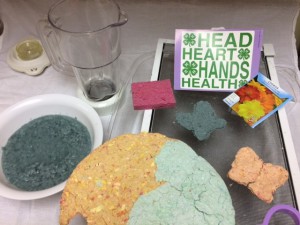
Grow Card Supplies and products
4-H literally got its start with gardening. The very first 4-H Clubs focused on growing tomatoes and corn for boys and canning for girls. Many youth and volunteers still enjoy gardening projects today. One great curricula that is used is the Junior Master Gardening Program. This program allows youth to enhance their life using gardening as the spark of interest. Gardening enriches youth’s lives, promotes good health, gives a sense of environmental awareness and saves money.
One of the activities I enjoy doing with youth combines gardening with recycling and crafting. As a group we will make our own paper grow cards or ornaments that have seeds embedded in them. Once the cards are dry, we deliver them as a service project. The cards are fun and inexpensive to make and are a perfect activity for your next club meeting! Try making them as valentines for Valentines Day. For beginners, we recommend growing tomatoes, lettuce, peppers, cucumbers, basil, chives, or parsley. Not into vegies? Try starting marigolds, cosmos, sunflowers, zinnias, pansies, or petunias.
Download our detailed factsheet with photos and directions. This activity is great for any occasion when you need a card or small gift. You can use as party favors by making them into ornaments using raffia to hang them from a tree or gift bag. You can take them to a nursing home, veterans center, hospital or other site as a service project for your club. Just be sure to share with the individual that they need to plant your card or ornament. It is a great way to help youth share their joy of gardening with others.
Other Extension gardening resources include:
• Florida Vegetable Gardening Guide
If you have a green thumb, consider going “totally green” as a 4-H gardening volunteer! 4-H needs caring adults like you to share their knowledge and passion for gardening with the next generation. Through the 4-H gardening project, youth not only learn gardening knowledge and skills, they also learn responsibility, teamwork, and other life skills that will help them grow up to be compassionate and competent citizens. To get involved, contact your local UF IFAS Extension Office, or visit Florida 4-H.
by Whitney Cherry | Dec 25, 2015
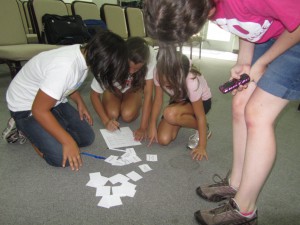
Enjoy a high-energy game of exercise bingo as you race other teams to see who can win! This game is available at your local extension office.
The New Year is upon us, and it is so fun to celebrate its coming with our families. Do you have a favorite New Year’s Tradition? If not, there is still time to plan one for this year! Here are a few fun and easy ideas to inspire you:
- New Year’s Eve Bonfire– roast hotdogs and marshmallows and enjoy hot chocolate by the fire. More family friendly campfire recipes
- Game Tournament– set up a tournament of games. You can play Minute to Win-It Style games, board games, or even electronic/video games. Each hour until midnight, let a family member choose their favorite game to play.
- Balloon Countdown– You will need a balloon for each hour of the countdown, depending on when you start. I recommend starting at 6PM, so you would need six balloons. Place a slip of paper with a craft, game or activity written on it. Place a slip in each balloon, then blow up the balloons and label each one with a number, representing each hour in the countdown until midnight. For example, at 6PM, have a family member pop the balloon with the number six on it, and then the family would do the activity listed on the slip of paper. Continue to pop balloons until midnight! Some of the activities you might include are: make paper hats, write down New Year’s Resolutions, make noisemakers, enjoy fireworks, etc.
- Progressive Hors d ’Oeuvres– this sounds fancy, but is really simple. Just prepare your family’s favorite snacks. Each hour, enjoy a different snack until midnight.
- Family Movie Night is another inexpensive favorite. Make homemade pizza or pop popcorn and enjoy a night in with your family.
- Fireworks can also be a fun activity, but be sure to read our tips on firework safety beforehand.
- Balloon Drop– a nice alternative to fireworks. Use masking tape to tape together 2 lengths of netting. Extend the tape to make a “rip cord.” Fill with balloons and confetti and tape to the ceiling (use painter’s tape so you do not damage the paint). At the stroke of midnight, pull on the rip cord and enjoy a cascade of celebratory balloons and confetti!
- And finally, you can go all in and recreate your favorite game shows. Imagine win-lose-or draw, family feud, the price is right…the possibilities are endless.
Do you have a favorite family New Year’s Eve tradition? If so, share in the comments! We want to thank you for another great year in 4-H! If you are not currently a 4-H member or volunteer, contact your local UF IFAS County Extension Office for more information, or visit http://florida4h.org for more information.
by Jenny Savely | Dec 19, 2015
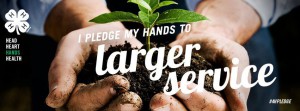
Clear evidence of mastering a skill is being able to employ it in one’s everyday life. Knowledge is only as good as how we are able to use it. 4-H dedicates itself to educating youth with research based curriculum not only for their own benefit but also so they can share that knowledge with others. When we “pledge our hands to larger service”, this can take on many forms. It may look like teaching youth in a community center about robotics or gardening, making meals for the military and first responders, or cleaning up trash in local parks. In all our service, it is important that regardless of what this looks like that we focus on meeting a need in our community. Identifying these needs is sometimes difficult if they are not part of what we see around us regularly. Talking to people who do not have the same life experiences we do is a good way to start seeing the world in a different way and thinking about ways you can help others who haven’t had the same opportunities. In Escambia County, around 30% of our youth population lives in poverty (US Census). Outcomes of living in poverty are hunger, poor housing, poor health, and lower educational scores, just to name a few. Our 4-Hers are learning to use the skills they have gained in 4-H in creative ways to help address some of these issues. One club has received a grant to raise a hog that a youth will show and have processed so the meat can be included in food boxes for local families. Another club raised funds to help support the Council on Aging to provide air conditioning units to the elderly, who are more likely to be impoverished, during the hot summer months.
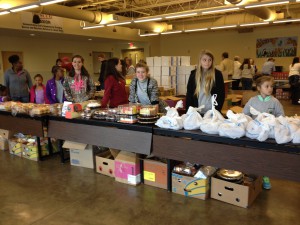
Escambia County 4-Hers assemble food boxes for local families at this year’s Farm to City event.
Whether poverty, pollution, safety, education, healthcare, or another issue is one that effects your community, the skills youth learn through 4-H can help address it. Not only does this help those around us live healthier and more productive lives, but it helps those who serve connect to their community and learn to give back. As with all 4-H projects, our goal is to help youth become more engaged and knowledgeable citizens that contribute to their world in positive ways. We encourage our youth to embody the spirit of generosity all year long, but during this season, be sure to explore the needs in your community you can help to change, even in the smallest way. If you need help thinking of how to best give back, contact your local 4-H Agent, local non-profits, or look up your county’s information in a database such as the US Census’ QuickFacts (http://quickfacts.census.gov/qfd/states/12000.html) and think about what kinds of problems might arise from the information you find there.
4-H also offers many Leadership and Citizenship projects that can help youth navigate assessing the needs of their community and putting their skills to use. You can find a few such project guides at the following links:
If you are interested in helping guide the next generation to be compassionate, active citizens for tomorrow, consider becoming a 4-H Volunteer. 4-H offers a wide variety of roles to fit your interests and schedule. Visit http://florida4h.org or contact your local UF IFAS Extension Office.
US Census. 2015. American Community Survey 2009-2013 five-year estimates, Children Characteristics: Escambia County, FL. Accessed November 18, 2015.

by Melanie Taylor | Dec 11, 2015
 The holidays are often filled with time-honored traditions that include some of our favorite meals and foods. As you celebrate, think of little changes you can make this holiday season to create healthier meals and active days. An added bonus, these small changes may help you to avoid those extra holiday pounds we all fear each year. Happy Cooking!
The holidays are often filled with time-honored traditions that include some of our favorite meals and foods. As you celebrate, think of little changes you can make this holiday season to create healthier meals and active days. An added bonus, these small changes may help you to avoid those extra holiday pounds we all fear each year. Happy Cooking!
In the Kitchen:
• For gravies or sauces — if you are making pan gravy, first skim the fat off pan drippings. For cream or white sauces, use fat-free (skim) milk and soft tub or liquid margarine.
• For dressings or stuffing — add low-sodium broth or pan drippings with the fat skimmed off instead of lard or butter. Use herbs and spices and a whole grain bread for added flavor.
• For biscuits — use vegetable oil instead of lard or butter and fat-free (skim) milk or 1 percent buttermilk instead of regular milk.
• For greens — use skin-free smoked turkey, liquid smoke, fat-free bacon bits, or low-fat bacon instead of fatty meats.
• For sweet potato pie — mash sweet potato with orange juice concentrate, nutmeg, vanilla, cinnamon, and only one egg. Leave out the butter.
• For cakes, cookies, quick breads, and pancakes — use egg whites or egg substitute instead of whole eggs. Two egg whites can be substituted in many recipes for one whole egg.
• Use unsweetened applesauce or mashed ripe bananas instead of butter.
• Try cutting the amount of sugar listed in recipes in half.
• Use spices to add flavor such as cinnamon, allspice, or nutmeg instead of salt.
• Try baked apples with cinnamon and a sprinkle of sugar instead of apple pie.
• Invite your guests to make their own parfait with colorful sliced fruit and low-fat yogurt.
For meats and poultry (chicken and turkey):
• Trim away all of the visible fat from meats and poultry before cooking.
• Take off poultry skin before eating.
• Broil, grill, roast, poach, or boil meat, poultry, or fish instead of frying.
• Drain off any fat that appears during cooking.
• Chill meat and poultry broth until fat becomes solid. Skim off fat before using the broth.
• Skip or limit the breading on meat, poultry, or fish. Breading adds fat and calories. It will also cause the food to soak up more fat during frying.
• Choose and prepare foods without high fat sauces or gravies.
When Shopping:
• Start with a lean choice.
• The leanest beef cuts include round steaks and roasts (round eye, top round, bottom round, round tip), top loin, top sirloin, and chuck shoulder and arm roasts.
• The leanest pork choices include pork loin, tenderloin, center loin, and ham.
• Boneless skinless chicken breasts and turkey cutlets are the leanest poultry choice.
Use the food label to help you choose
• Choose extra lean ground beef. The label should say at least “90% lean.” You may be able to find ground beef that is 93% or 95% lean.
• Processed meats such as hams, sausages, frankfurters, and luncheon or deli meats have added sodium. Check the ingredient and Nutrition Facts label to help limit sodium intake.
• Fresh chicken, turkey, and pork that have been enhanced with a salt-containing solution also have added sodium. Check the product label for statements such as “self-basting” or “contains up to __% of __.”
• Lower fat versions of many processed meats are available. Look on the Nutrition Facts label to choose products with less fat and saturated fat.
De-Saturate
• Use a nonstick pan with vegetable cooking oil spray or a small amount of liquid vegetable oil instead of lard, butter, shortening, or other fats that are solid at room temperature.
Enjoy the Food, Fun, Friends and Family!
Cheers to Good Health
• Quench your thirst with low-calorie options. Drink water with lemon or lime slices. Offer seltzer water with a splash of 100% fruit juice.
Be the Life of the Party
• Laugh, mingle, dance, and play games. Focus on fun and enjoy the company of others.
Give to Others
• Spend time providing foods or preparing meals for those who may need a little help. Give food to a local food bank or volunteer to serve meals at a shelter during the holiday season. Giving back is a great mood booster.
Make Exercise a Part of the Fun
• Make being active part of your holiday tradition. Have fun walking and talking with family and friends after a holiday meal. Give gifts that encourage others to practice healthy habits such as workout DVDs, running shoes, and reusable water bottles.
Enjoy the Leftovers
• Create delicious new meals with your leftovers. Add turkey to soups or salads. Use extra veggies in omelets, sandwiches, or stews. The possibilities are endless!
Be sure your family and friends enjoy the food and fun, but focus on the time together. Remember this season is all about the memories, not just the food. You will feel better and enjoy your holiday time with less worry if you focus on staying healthy this season.
Source: USDA United States Department of Agriculture – www.MyPlate.gov

 Her entrepreneurial spirit, developing mastery in hog raising, and the leadership skills she has learned will translate into the lifelong values and behavioral change we see in many of our 4-H’ers that have let their experiences direct how they think of others, themselves, and their place in the world.
Her entrepreneurial spirit, developing mastery in hog raising, and the leadership skills she has learned will translate into the lifelong values and behavioral change we see in many of our 4-H’ers that have let their experiences direct how they think of others, themselves, and their place in the world. One of the most important skills 4-H teaches is to use your head, heart, hands, and health not only for oneself but for club, community, country, and world. Years of community service through 4-H have helped to mold Danielle into an empathetic and thoughtful young woman.
One of the most important skills 4-H teaches is to use your head, heart, hands, and health not only for oneself but for club, community, country, and world. Years of community service through 4-H have helped to mold Danielle into an empathetic and thoughtful young woman.






